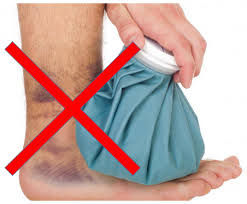IS ICING INJURIES THE BEST THING TO DO?
- Anthony Kassis
- Feb 2, 2019
- 2 min read
The acronym ‘RICE’ or ‘RICER’ has been taught for decades as the best way to treat any soft tissue injury. If someone has an injury, they need to ICE IT straight away!
Recently I watched an NBA game and saw Lebron James injure his hamstring whilst trying to defend against an opposition and the immediate response from the on hand therapists was to ICE the injured area. I don’t agree with this and in my opinion, it would have slowed down his rate of recovery.
Another example is when I see NRL players having ice taped to their hamstrings, ankles, knees, shoudlers, elbows, fingers or whatever other body part they hurt in a game. Again, this just delays the rate of recovery of these athletes.
Should You Use RICE to Treat Injuries?
In a recent study, athletes exercised at such a high intensity that they developed severe muscle damage that caused extensive ‘delayed onset muscle soreness’ (DOMS). Although cooling delayed swelling, it did not help with recovery from this muscle damage (The American Journal of Sports Medicine, June 2013).
Applying ice to injured tissue causes blood vessels near the injury to constrict and shut off the blood flow that brings in the healing cells of inflammation (Knee Surg Sports Traumatol Arthrosc, published online Feb 23, 2014). The blood vessels do not open again for many hours after the ice was applied. Which delays the healing process and is counterproductive to the athletes recovery.
Healing Requires Inflammation
This may sound a little bit counterintuitive at first, but it makes perfect sense, you need inflammation to heal. When you damage tissue through trauma or develop muscle soreness by exercising very intensely, you heal by using your immunity. This is called inflammation. When muscles and other tissues are damaged, your immunity sends cells and protein to the damaged tissue to promote healing. The response to both infection and tissue damage is the same. Inflammatory cells rush to injured tissue to start the healing process (Journal of American Academy of Orthopedic Surgeons,1999).
The inflammatory cells called macrophages release a hormone called Insulin-like Growth Factor (IGF-1) into the damaged tissues, which helps muscles and other injured parts to heal. However, by applying ice to reduce swelling actually delays healing by preventing the body from releasing IGF-1.
I preach to all my clients, ‘It’s not what you can do, it’s what you can recover from’. This is why I promote heating as opposed to icing.
Dr. Mirkin also mentions in his new findings that anything that reduces your immune response will also delay muscle healing.
Thus, healing is delayed by:
• cortisone-type drugs
• almost all pain-relieving medicines, such as non-steroidal anti-inflammatory drugs like ibuprofen
• immune suppressants that are often used to treat arthritis, cancer or psoriasis
• applying cold packs or ice, and
• anything else that blocks the immune response to injury
The above reasons on why icing isn’t the best way of treating a soft tissue injuries, are the reason why I seek heating injured areas STRAIGHT away and why I strongly believe that the sexy acronym ‘RICE’ needs to go.
Agree or disagree, it doesn’t bother me. The facts speak for themselves. The next time you suffer an injury, try heating it instead of icing it and see how much faster the area heals.
Yours in health,

Coach Anthony Kassis








Comments